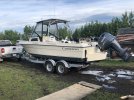There area few things to remember when boats get pods, first is you are creating a huge shift in the center of gravity in respect to the center of buoyancy, this amplifies the effect of swamping the motor when slowing down,
@fishin solo is correct as most people just cut the throttle rather than slowing down progressively before they learn proper boat handling.
Also in general you don’t pod boats under a certain size, if you talk to Armstrong brackets they actually don’t recommend podding under 24’, Unless the boat is particularly heavy as it shifts the center of gravity farther than practical. Also in cases of smaller boats its considered best practice to glass in the old engine cutout into a flat transom as the possibility of swamping the stern is greater due to the CG shift.
In your case that 500lb engine (plus 100lb bracket) has shifted the CG about 2 feet back, and on a 21’ boat that equates to 10% CG shift without adding a sufficient amount of buoyancy. the bracket will probably provide about 300lbs of positive buoyancy when mostly submerged which helps to partially compensate for the shift in the CG. However by comparison, the hull profile of the same area would provide about 800-1000lbs of buoyancy. That hull is probably sitting at 2500-3000lbs, so moving 1/6th of the mass 10% rearward will have a drastic effect on how the boat comes on and off plane.
So what this equates to is an excessive amount of squat when accelerating and decelerating, when decelerating your engine is literally trying to pivot under the boat around a point that defined by a relationship between the CG and CB, and when accelerating the engine is trying to push itself under your boat. This can sometimes be mitigated to some degree with trim tabs or a foil, however a foil will reduce the fuel savings from the podding and reduce your top speed. Its also likely you will have to actively adjust trim at different speeds to avoid porposing. In the end this boat probably should not have been podded, he was probably sold on the idea of fuel savings and higher speeds, however its all basically a compromised engineering project. Do pods work, yes, but not on all boats, as to be properly effective there need to be actual planning, calculation and engineering work, just buying a pod and bolting it on will not provide the best solution unless someone has done the work to design it for your boat. This would not be the first time that a boat has been podded when it really probably shouldn't have been.


